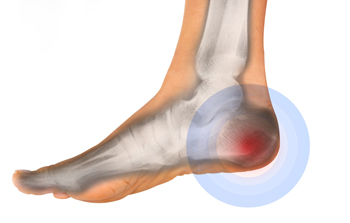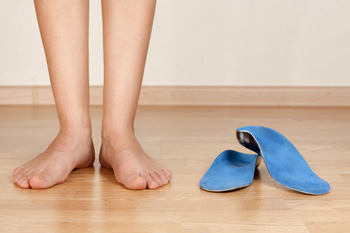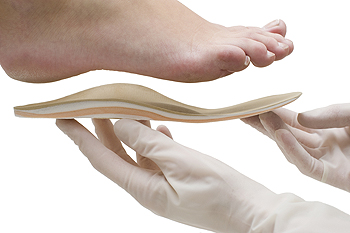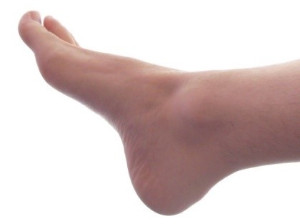Blog
Children and Sever’s Disease
 A common foot condition many children may endure is referred to as Sever’s disease. Despite the fact that this bone disorder of the heel may occur in any child, research has shown it may be more common in children who are involved in sporting activities. This type of foot ailment may develop as pressure is put on the heel growth plate, which may be a result of overstretched muscles and tendons. Some of the uncomfortable symptoms may include pain, swelling and tenderness in the back of the heel and surrounding areas. Patients who have one leg that is shorter than the other, a foot that rolls inward while walking, or is overweight may be more susceptible in developing Sever’s disease. If your child complains of heel pain, it is advised to seek the counsel of a podiatrist who can properly diagnose and treat Sever’s disease.
A common foot condition many children may endure is referred to as Sever’s disease. Despite the fact that this bone disorder of the heel may occur in any child, research has shown it may be more common in children who are involved in sporting activities. This type of foot ailment may develop as pressure is put on the heel growth plate, which may be a result of overstretched muscles and tendons. Some of the uncomfortable symptoms may include pain, swelling and tenderness in the back of the heel and surrounding areas. Patients who have one leg that is shorter than the other, a foot that rolls inward while walking, or is overweight may be more susceptible in developing Sever’s disease. If your child complains of heel pain, it is advised to seek the counsel of a podiatrist who can properly diagnose and treat Sever’s disease.
Sever's disease often occurs in children and teens. If your child is experiencing foot or ankle pain, see one of our podiatrists from Pennsylvania. Our doctors can treat your child’s foot and ankle needs.
Sever’s Disease
Sever’s disease is also known as calcaneal apophysitis, which is a medical condition that causes heel pain I none or both feet. The disease is known to affect children between the ages of 8 and 14.
Sever’s disease occurs when part of the child’s heel known as the growth plate (calcaneal epiphysis) is attached to the Achilles tendon. This area can suffer injury when the muscles and tendons of the growing foot do not keep pace with bone growth. Therefore, the constant pain which one experiences at the back of the heel will make the child unable to put any weight on the heel. The child is then forced to walk on their toes.
Symptoms
Acute pain – Pain associated with Sever’s disease is usually felt in the heel when the child engages in physical activity such as walking, jumping and or running.
Highly active – Children who are very active are among the most susceptible in experiencing Sever’s disease, because of the stress and tension placed on their feet.
If you have any questions, please feel free to contact one of our offices located in Plymouth Meeting and Ambler, PA . We offer the newest diagnostic and treatment technologies for all your foot and ankle injuries.
Are Flat Feet Considered to be a Serious Condition?
 For many people, having flat feet may be a condition that generally causes little or no concern. When this condition occurs, the feet will lay flat on the ground as a result of an absent arch. Research has shown that most babies are born with flat feet, and the arches will typically develop at approximately six years of age. While flat feet or fallen arches do not hinder daily activities for many people, there may be symptoms that may cause discomfort for certain people. These may include the feet feeling stiff or experiencing a numbing sensation. Additionally, some people may have difficulty in balancing or walking, or one foot may possibly be affected. Possible treatment options may include wearing shoes that have a low heel, or using insoles in the shoes, which may offer adequate support. It’s suggested to speak with a podiatrist who can advise you on what the best treatment options are for you.
For many people, having flat feet may be a condition that generally causes little or no concern. When this condition occurs, the feet will lay flat on the ground as a result of an absent arch. Research has shown that most babies are born with flat feet, and the arches will typically develop at approximately six years of age. While flat feet or fallen arches do not hinder daily activities for many people, there may be symptoms that may cause discomfort for certain people. These may include the feet feeling stiff or experiencing a numbing sensation. Additionally, some people may have difficulty in balancing or walking, or one foot may possibly be affected. Possible treatment options may include wearing shoes that have a low heel, or using insoles in the shoes, which may offer adequate support. It’s suggested to speak with a podiatrist who can advise you on what the best treatment options are for you.
Flatfoot is a condition many people suffer from. If you have flat feet, contact one of our podiatrists from Pennsylvania. Our doctors will treat your foot and ankle needs.
What Are Flat Feet?
Flatfoot is a condition in which the arch of the foot is depressed and the sole of the foot is almost completely in contact with the ground. About 20-30% of the population generally has flat feet because their arches never formed during growth.
Conditions & Problems:
Having flat feet makes it difficult to run or walk because of the stress placed on the ankles.
Alignment – The general alignment of your legs can be disrupted, because the ankles move inward which can cause major discomfort.
Knees – If you have complications with your knees, flat feet can be a contributor to arthritis in that area.
Symptoms
- Pain around the heel or arch area
- Trouble standing on the tip toe
- Swelling around the inside of the ankle
- Flat look to one or both feet
- Having your shoes feel uneven when worn
Treatment
If you are experiencing pain and stress on the foot you may weaken the posterior tibial tendon, which runs around the inside of the ankle.
If you have any questions please feel free to contact one of our offices located in Plymouth Meeting and Ambler, PA . We offer the newest diagnostic and treatment technologies for all your foot and ankle needs.
The Benefits of Using Orthotics
 Many people have chosen to use orthotics in their shoes for the primary reason of relieving pain and discomfort that may be associated with certain foot conditions. There may be many beneficial reasons for using orthotics including maintaining proper arch support, relieving uncomfortable pressure the feet may endure from daily activities, and to aid in diminishing heel pain. Research has shown that body weight may be easier to balance on the feet when the proper orthotics are used. A common reason to use orthotics may be overpronation, which is the term referred to when the foot rolls too far inward. If left untreated, it may cause a plethora of additional foot ailments, including bunions, calluses, and plantar fasciitis, which is an inflammation of the tissue that runs along the sole of the foot. If you would like additional information about orthotics, please consult with a podiatrist who can properly measure your foot for these devices.
Many people have chosen to use orthotics in their shoes for the primary reason of relieving pain and discomfort that may be associated with certain foot conditions. There may be many beneficial reasons for using orthotics including maintaining proper arch support, relieving uncomfortable pressure the feet may endure from daily activities, and to aid in diminishing heel pain. Research has shown that body weight may be easier to balance on the feet when the proper orthotics are used. A common reason to use orthotics may be overpronation, which is the term referred to when the foot rolls too far inward. If left untreated, it may cause a plethora of additional foot ailments, including bunions, calluses, and plantar fasciitis, which is an inflammation of the tissue that runs along the sole of the foot. If you would like additional information about orthotics, please consult with a podiatrist who can properly measure your foot for these devices.
If you are having discomfort in your feet and would like to try orthotics, contact one of our podiatrists from Pennsylvania. Our doctors can provide the care you need to keep you pain-free and on your feet.
What Are Orthotics?
Orthotics are inserts you can place into your shoes to help with a variety of foot problems such as flat feet or foot pain. Orthotics provide relief and comfort for minor foot and heel pain but can’t correct serious biomechanical problems in your feet.
Over-the-Counter Inserts
Orthotics come in a wide variety of over-the-counter inserts that are used to treat foot pain, heel pain, and minor problems. For example, arch supports can be inserted into your shoes to help correct overarched or flat feet, while gel insoles are often used because they provide comfort and relief from foot and heel pain by alleviating pressure.
Prescription Orthotics
If over-the-counter inserts don’t work for you or if you have a more severe foot concern, it is possible to have your podiatrist prescribe custom orthotics. These high-quality inserts are designed to treat problems such as abnormal motion, plantar fasciitis, and severe forms of heel pain. They can even be used to help patients suffering from diabetes by treating foot ulcers and painful calluses and are usually molded to your feet individually, which allows them to provide full support and comfort.
If you are experiencing minor to severe foot or heel pain, it’s recommended to speak with your podiatrist about the possibilities of using orthotics. A podiatrist can determine which type of orthotic is right for you and allow you to take the first steps towards being pain-free.
If you have any questions please contact one of our offices located in Plymouth Meeting and Ambler, PA . We offer the newest diagnostic and treatment technologies for all your foot and ankle needs.
What is Tarsal Tunnel Syndrome Caused By?
 If you experience discomfort and pain on the inside of your foot, you may have what is referred to as tarsal tunnel syndrome. This condition may also be called TTS, and may result from constant overuse of the ankle and foot. Activities that can cause this ailment to develop may include walking, exercising or running and can also occur from a serious injury. The surrounding area may become inflamed as a result of damaged nerves, which may have a negative impact in performing daily activities. Research has shown that early diagnosis and treatment of tarsal tunnel syndrome may accelerate the healing process, which may typically begin with resting the foot. Severe cases of this condition may be treated with orthotics or physical therapy. It’s suggested to speak with a podiatrist as quickly as possible to ensure that a proper diagnosis is performed and the correct treatment options are discussed.
If you experience discomfort and pain on the inside of your foot, you may have what is referred to as tarsal tunnel syndrome. This condition may also be called TTS, and may result from constant overuse of the ankle and foot. Activities that can cause this ailment to develop may include walking, exercising or running and can also occur from a serious injury. The surrounding area may become inflamed as a result of damaged nerves, which may have a negative impact in performing daily activities. Research has shown that early diagnosis and treatment of tarsal tunnel syndrome may accelerate the healing process, which may typically begin with resting the foot. Severe cases of this condition may be treated with orthotics or physical therapy. It’s suggested to speak with a podiatrist as quickly as possible to ensure that a proper diagnosis is performed and the correct treatment options are discussed.
Tarsal tunnel syndrome can be very uncomfortable to live with. If you are experiencing tarsal tunnel syndrome, contact one of our podiatrists of Pennsylvania. Our doctors can provide the care you need to keep you pain-free and on your feet.
Tarsal Tunnel Syndrome
Tarsal tunnel syndrome, which can also be called tibial nerve dysfunction, is an uncommon condition of misfiring peripheral nerves in the foot. The tibial nerve is the peripheral nerve in the leg responsible for sensation and movement of the foot and calf muscles. In tarsal tunnel syndrome, the tibial nerve is damaged, causing problems with movement and feeling in the foot of the affected leg.
Common Cause of Tarsal Tunnel Syndrome
- Involves pressure or an injury, direct pressure on the tibial nerve for an extended period of time, sometimes caused by other body structures close by or near the knee.
- Diseases that damage nerves, including diabetes, may cause tarsal tunnel syndrome.
- At times, tarsal tunnel syndrome can appear without an obvious cause in some cases.
The Effects of Tarsal Tunnel Syndrome
- Different sensations, an afflicted person may experience pain, tingling, burning or other unusual sensations in the foot of the affected leg.
- The foot muscles, toes and ankle become weaker, and curling your toes or flexing your foot can become difficult.
- If condition worsens, infections and ulcers may develop on the foot that is experiencing the syndrome.
A physical exam of the leg can help identify the presence of tarsal tunnel syndrome. Medical tests, such as a nerve biopsy, are also used to diagnose the condition. Patients may receive physical therapy and prescriptive medication. In extreme cases, some may require surgery.
If you have any questions please feel free to contact one of our offices located in Plymouth Meeting and Ambler, PA . We offer the newest diagnostic and treatment technologies for all your foot and ankle needs.
